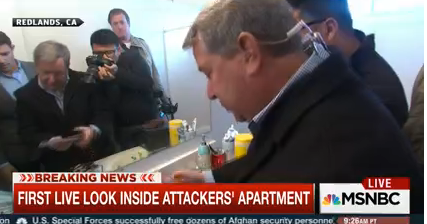
NEW YORK -- NBC News correspondent Kerry Sanders drew criticism Friday for showing close-up images of photographs and identification cards live on MSNBC, as he found them, in the home of San Bernardino shooting suspects Syed Farook and Tashfeen Malik.
"We regret that we briefly showed images of photographs and identification cards that should not have been aired without review," an MSNBC spokesperson said in a statement.
Before entering the house with a horde of journalists, however, Sanders touted NBC's ethical standards, saying the network wouldn't pay for access to the house as a competitor allegedly did. He told MSNBC anchor Andrea Mitchell that "Inside Edition" had paid Doyle Miller, the building's landlord, $1,000 to get the first look inside.
“I said, ‘Look, NBC’s not going to pay to come in,'" Sanders recalled of his conversation with the landlord. He told Mitchell the landlord said they could enter after "Inside Edition" and that he had "no reason to hide anything."
Sanders said on air that hopefully his crew will "be the second camera walking in" and they'll go "straight in and see what we see."
"MSNBC and other news organizations were invited into the home by the landlord after law enforcement officials had finished examining the site and returned control to the landlord," the MSNBC spokesperson said in the statement. "Although MSNBC was not the first crew to enter the home, we did have the first live shots from inside."
The bizarre scene of journalists rifling through the suspects' home on live TV, just two days after the shooting, sparked criticism on social media and concern among law enforcement experts. But if authorities completed their investigation inside the house, and the landlord permitted journalists inside, it'd be hard to imagine them not going in. It may be ugly to watch, but competitive journalists can be expected to race, even push, to get newsworthy information that might shed light on the suspects' motivations.
Still, it's essential that journalists exercise sound editorial judgment to not put others in danger by broadcasting private and sensitive information. MSNBC failed to do that.
In the couple's child's room, Sanders flipped through a wall calendar, pointed out a prayer rug, rifled through some paper left in a shredder, and noted innocuous items in his line of sight -- a $7.98 check for Chase bank, children's toys, a bag of mixed nuts.
Things got out of control in the next room as NBC's camera zoomed in on photographs, including several featuring children -- all of whom may have little to no connection to the suspects, and certainly no role in the shooting. Sanders speculated that one photo was the first known image of the shooter. "I’m going to guess that these are the photographs of Malik," he said.
Sanders later acknowledged he couldn't be sure if it was Malik and Mitchell emphasized that the network wasn't verifying it was her. Still, Sanders proceeded to flip through several photos as his cameraperson filmed close-ups. In the next room, Sanders held up to the camera ID's belonging to Rafia Farook, the suspect's mother, close enough for her personal information to be visible.
CNN, Fox News and CBS also broadcasted live from inside the suspects' home, though the networks didn't appear to zoom in on similarly sensitive materials.
A CNN spokesperson noted that distinction in a statement to The Huffington Post.
"CNN, like many other news organizations, was granted access to the home by the landlord," the spokesperson said. "We made a conscious editorial decision not to show close-up footage of any material that could be considered sensitive or identifiable, such as photos or ID cards."
A CBS News correspondent said during the network's live-streamed coverage that they were trying not to show close-ups of photographs.
But close-ups or not, some argued the media's treatment of the suspects' possessions was problematic in that potential evidence could be lost.
“I’m having chills down my spine what I’m seeing here," analyst Harry Houck said amid images of journalists rummaging through the house.
"This apartment clearly is full of evidence, he continued. "I don’t see any fingerprint dust on the walls where they went in there and checked for fingerprints of other people who might have been connected with these two," he said. "You have documents laying all over the place. You have shredded documents that need to be taken out of there to see what’s shredded. You have passports. You’ve got drivers’ licenses. Now you have thousands of fingerprints all over this crime scene."
Gabriel Arana contributed reporting.
